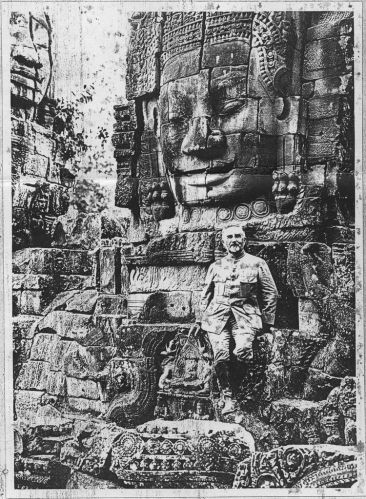
FINOT Louis (EN)
Biographical Article
After earning a degree in law and letters, Louis Finot was admitted to the École des chartes in 1886. He graduated two years later with the title of Archivist-Paleographer. He first worked as a trainee (1890), then as assistant librarian at the Bibliothèque nationale (1892), and began studying Sanskrit at the École des Hautes Etudes with Sylvain Lévi (1863-1935), from which he graduated in 1894. He was then appointed deputy director of Sanskrit conferences at the École des Hautes Etudes, then in 1898 director of the Mission archéologique in Indochina, the scientific institution founded by Paul Doumer (1857-1932), which in 1900 became the École française d'Extrême-Orient (EFEO), or French School of Asian Studies. His career was now clearly mapped: it would be one with these nascent institutions. Upon reaching Indochina, his first task was to travel through all the countries of the union, in the company of Antoine Cabaton (1863-1942) and Captain Lunet de Lajonquière (1861-1933), before returning to Saigon to carry out the development of its program and to oversee the installation of a library and a museum. For this, he took the model of the Société des arts et des sciences de Batavie, the oldest of all the scientific societies of the Far East, whose organisation and functioning he studied on site in August-September 1899. In 1901, he authoredan article in the first BEFEO entitled "La religion des Chams” followed by an "Inventaire des monuments", a translation, eighteen minutes and two activity reports. He held the first International Congress of Far Eastern Studies in Hanoi the following year. At the end of his mandate, on December 31, 1904, he was replaced by Alfred Foucher as director of the School, but instead of returning directly to Paris, he traveled through Siam, Burma, and India, before returning to teaching. In 1907, he took charge of the chair of Indochinese history and philology at the École des Hautes Etudes and the Collège de France, but interrupted his courses in 1914 to once again assume the direction of the school, upon the mobilisation of the erstwhile director Claude-Eugene Maitre. He soon returned to Indochina and resumed his work on various texts and inscriptions, before returning to France in 1918, where two years later (December 1920), against all odds, he was asked by the Academy to undertake the direction of the school, which he would oversee until 1926. He then left for Angkor in the company of Victor Goloubew (1878-1945), in order to see the Bayon and Neak Pean again, then went to Bantey Chmar and visited several "stopover lodgings". This trip allowed him to acquire the certainty that all these buildings were built by a Buddhist sovereign. Based on this discovery, he wrote several articles that allowed Philippe Stern (1927) and George Coedès (1928) to date their construction to the reign of Jayavarman VII (ជ័យវរ្ម័នទី៧) [1181-1218]. Alongside his archaeological activities, Louis Finot maintained close relations with the Pali School of Phnom Penh and contributed, through Suzanne Karpelès (1890-1968), to the creation of the Royal Library (August 1925). He obtained the creation of the Angkor Archaeological Park, which benefited from more active surveillance and special legislation. He also created a new collection for the school: the "Mémoires archéologiques". The new director of the school, Léonard Aurousseau (1888-1929), returned to France for health reasons and died soon thereafter. This event prompted Louis Finot to once again act as interim director and travel to Saigon in 1928. He was finally replaced in 1929 by George Coedès (1886-1969). He left Saigon in January 1930 to settle in Toulon. Elected member of the Académie des Inscriptions et Belles-Lettres in 1933, he died two years later.

The Collection
The Louis Finot collection is made up of 2,779 stereoscopic photographs, taken between 1898 and 1930 in Cambodia, Laos, Thailand, Vietnam, and China, as well as 122 small Sino-Tibetan bronzes, some lacquered wood and enamelled ceramics collected in China by Paul Pelliot (1878-1945) at the request of Louis Finot in 1900.

Related articles
Collection / collection d'une personne

Personne / personne

